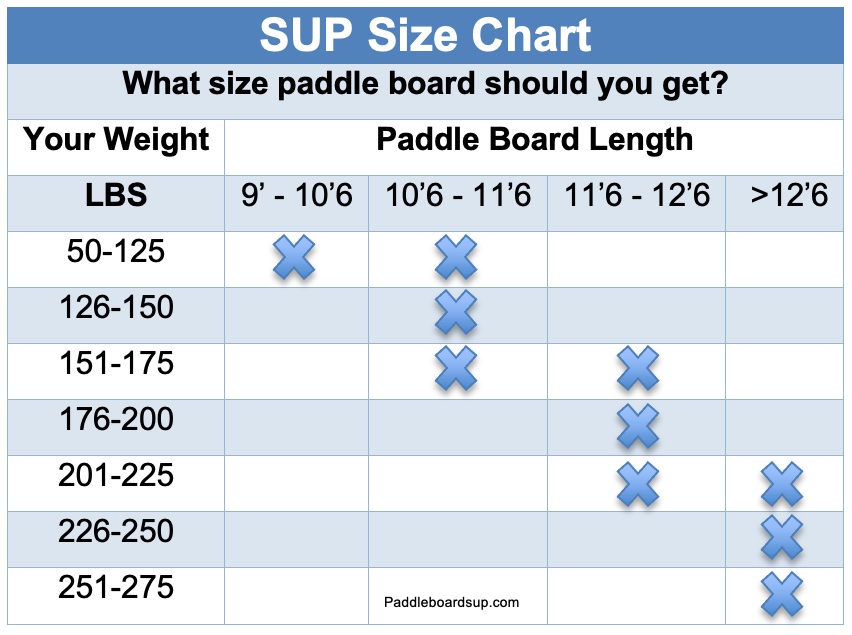Why Size Matters
So what size paddle board should you get? You’ve been perusing the sites. You’ve seen the paddle boarders enjoy their days on your nearest waterway and you just want to try it out!
Hold your horses! You can’t just go up to any store or even any waterway and start your journey. You’ll need to equip yourself the right way. The very first thing you need to do is get the paddle board that would be perfect for you.
Why? This is the perfect case that size does matter. Getting the paddle board size correct is the sure way to assure you the best chances of ease in learning and prevent many accidents that can happen during your paddle boarding experience.
The SUP size chart below is a rough guide to what size paddle board you should get based on your weight. You’ll have to consider whether the board can provide enough flotation and stability depending on your weight and skill level. If you are just planning to paddle alone on rivers or calm sea on a general all around board (check out types of board if you’re unsure) then going by this should do you fine. However, there are other considerations.

Other considerations are the type of paddle boarding you want to partake in. Some paddle boards are perfect for activities like long-haul exploring, others are better for SUP Yoga, and there’s one that’s right in the middle. So, to recap it all depends on you and the activities you’ll be doing!
There are two dimensions to look at when choosing your board. The two are:
1) Weight Capacity
2) Length
1) Weight Capacity
Weight capacity largely determines your success in the water. It also varies per type and per model. So, this is something you should first check when you’re looking for your board. The rule of thumb is that you should be lighter than the weight capacity of the paddle board. If you exceed the weight capacity, the board tends to ride lower or drag in too much water, which will make it so much more difficult or nearly impossible to paddle.
When calculating for the ideal weight capacity you’ll need, please consider any add-ons you’ll be bringing onto the board. If it will be a quick adventure by the shore, you can get away with just taking your measurements. But if you are ever planning to go paddle boarding with your pets, kids, or friends, you’ll need to factor in their weight as well. Another consideration is any gear or supplies you’ll be bringing. This is especially important for paddle boarders that intend to camp out and will be bringing heavier gear with them.
Weight capacity does differ between an inflatable paddle board and an epoxy-type paddle board. Obviously, the inflatable paddle board will be much easier to take with you. It’s thin and very good for children or light paddlers.
If you are heavier, you’ll need something sturdier. What is recommended is to go for a right-sized epoxy paddle board that helps you effortlessly go through water. This is perfect for surfing and touring too!
2) Length and Boards by Activity
Paddle board length rather does not vary too much person to person. When choosing the length of your paddle board, it actually largely depends on the activities you’ll be doing, not just your weight or height. It also depends if you’re planning to paddle alone or bringing anything else on board and the conditions of the water and weather when you’ll be paddling. But an easy to follow rule would be to add anywhere between 9-10 inches from the height of the paddler.
When choosing a paddle board, you should also consider the different SUP activities you plan on doing. Here are some of the more popular activities and the recommended size for each:
a) Touring or Racing Paddle Boarding
For any long-haul journeys or times you’ll need speed, generally you should choose something a little longer. An epoxy board that is 10-12 inches taller than the paddler could be your best bet. This allows you to have a narrower board, making you faster. However, it could also be less stable so it is recommended to only go for this when you’re already more experienced.
b) Yoga SUPs
Now, for this activity, it’s all about stability. Generally Yoga SUP paddlers will choose calm water, so anything with a comfortable deck pad should be perfect for you. You can choose either an inflatable board for easy movement or stick to an epoxy board to help with stability. An ideal size mid-length which would be about 10′-12’6 feet.
c) Surfing SUPs
Yes, stand up paddle boards can also double as a surfboard. The ideal length to catch some waves is actually smaller than average. This allows you to maintain your stability and maneuver the board easily through the waves. It is recommended to go for a board that is about 9-10 feet.
Beginners
Now, that you know all the considerations, it is time to think about all your paddle boarding needs and go to your nearest water sports store or online store. Generally, for beginners who are just learning now, it’s best to think about stability. Check the weight capacity but generally a mid-length inflatable SUP paddle board would do just the trick. Happy paddling!
Leave a Reply